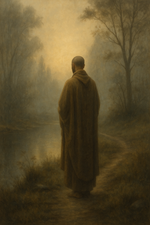Intro – What is Chidakasha, really?
Chidakasha (from Sanskrit chit = consciousness and ākāśa = space)
/ˈtʃɪ.dɑː.kə.ʃə/
Chidakasha is a term from yogic psychology. It refers to the inner space of consciousness—often felt behind the forehead, behind closed eyes. A space where images, insights, and subtle impressions arise.
But what if Chidakasha isn’t just an inner screen?
What if it’s a shared perceptual field—one that others can feel you enter, even without words or gestures?
This isn’t a theoretical question. It happened.
Not in a retreat, not in deep trance, but during a loud and chaotic stick fight in my living room.
What follows is a moment in which that space—the so-called sky of consciousness—became interpersonal. And visible.
Chopstick Swordplay – Entering the Inner Camera
My sons were fighting. Not symbolically, not gently—they were feasting on the full sensory thrill of combat. Two chopsticks each, a cry across the room:
“Let’s fence!” 🥢
I was afraid for their eyes. And, truthfully, for mine too.
So I wrapped myself in a blanket—not to retreat fully, but to protect myself while staying in the room. I turned inward and activated the inner camera. I left my chopstick floating mid-air—just enough to stay part of the game.
What followed was not imagination, not fantasy. It was vision. I could hear the softer clacking of the sticks. I felt the shifts in air pressure as they spun past each other. I saw—inwardly—shapes and movements, shadows and intention.
Then, something happened. They stopped. Looked at me. And suddenly shouted:
“The Genghi feels! The Genghi feels!”
Then they burst into laughter, racing through the apartment like something huge had just broken open.
They had noticed. Something in me had changed. I was no longer watching them. I was with them.
Interlude – the Peter Pan moment
It reminded me of something I had long forgotten.
Not just the story of Peter Pan, but the felt world it pointed to.
I had known the story, of course—believe to fly, never grow up, second star to the right. But I didn’t understand that it wasn’t about imagination, shedding of identity, or mere childhood fantasy.
I didn’t think my yogic self-work would ever apply there—in the middle of a stick fight.
Not escape. Not transcendence.
But the moment when inner presence becomes visible—to others.
When you stop pretending, and actually enter the field.
You can't fake flight.
You can't fake resonance.
And you can't fake being felt.
They knew the difference between pretending to play and actually playing along, even without touching a stick.
What struck me most wasn’t just that I could feel or see something internally—but that they could tell.
It wasn’t just a private field.
It became shared.
Not metaphorically, but experientially.
Not imagined. Not mystical. Undeniably real—between us.
Chidakasha, Mirror Neurons & Participatory Simulation
From a psychological perspective, this moment sits at the intersection of several concepts:
- Mirror neurons: Brain cells that respond not only when we perform an action, but when we witness someone else do it. The system enables empathy, mimicry, and internal resonance.
- Sensorimotor simulation: The internal reenactment of movements, sounds, and spatial dynamics, often below conscious awareness.
- Interaffectivity: A term from phenomenological psychology (e.g. Fuchs, Ratcliffe) describing how emotional states are co-constructed, shared, and felt between people.
In yogic language, we would say the Chidakasha was active—and not only within me. It became a shared atmosphere.
In psychological terms: my inner simulation became transparent to their perception. They saw I had entered the field.
And here’s what’s crucial:
You don’t need to "do" anything to enter that field.
You don’t even need to move. But you do need to mean it.
Conclusion – A Training Ground in Disguise
This wasn’t a prepared mystical moment. No incense. No OM. Just two children, two sticks, and a parent willing to tune in—without taking over.
In a world that demands performance, withdrawal, or control, participatory stillness is radical.
And sometimes, the deepest training ground is a living room.
So next time you enter the vision phase of a Nidra session, remember: it’s not just imagery.
It’s a real field. And it can be shared.




